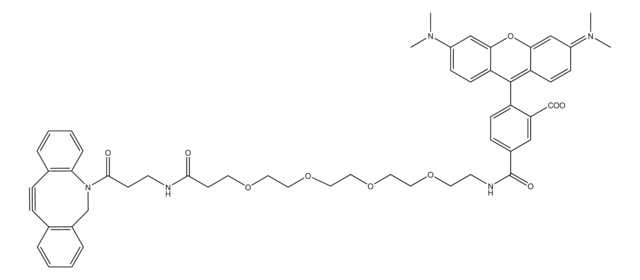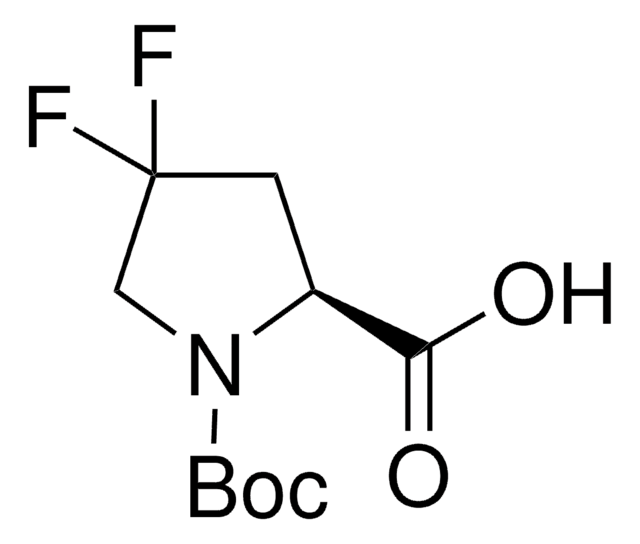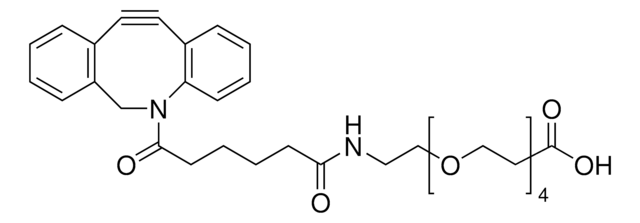777366
DBCO-Cy3
for Copper-free Click Chemistry
Sinónimos:
ADIBO-Cy3, Azadibenzocyclooctyne-Cy3, Dibenzocyclooctyne-Cy3
About This Item
Productos recomendados
Quality Level
form
solid
reaction suitability
reaction type: click chemistry
storage temp.
−20°C
SMILES string
CC1(C)C(/C=C/C=C2N(CCCS([O-])(=O)=O)C3=CC=C(S(=O)([O-])=O)C=C3C/2(C)C)=[N+](CCCCCC(NCCC(N4CC(C=CC=C5)=C5C#CC6=C4C=CC=C6)=O)=O)C7=C1C=C(S(=O)([O-])=O)C=C7.CC[NH+](CC)CC.CC[NH+](CC)CC
InChI
1S/C50H54N4O11S3.2C6H15N/c1-49(2)40-32-38(67(60,61)62)23-25-43(40)52(45(49)18-12-19-46-50(3,4)41-33-39(68(63,64)65)24-26-44(41)53(46)30-13-31-66(57,58)59)29-11-5-6-20-47(55)51-28-27-48(56)54-34-37-16-8-7-14-35(37)21-22-36-15-9-10-17-42(36)54;2*1-4-7(5-2)6-3/h7-10,12,14-19,23-26,32-33H,5-6,11,13,20,27-31,34H2,1-4H3,(H3-,51,55,57,58,59,60,61,62,63,64,65);2*4-6H2,1-3H3
InChI key
HDOXKDFHZWYVPF-UHFFFAOYSA-N
Categorías relacionadas
Application
Solubility: DMSO; DMF
Abs/Em: 553/563 nm
Extinction Coefficient:: 151,000 cm-1M-1
signalword
Warning
hcodes
Hazard Classifications
Eye Irrit. 2 - Skin Irrit. 2 - STOT SE 3
target_organs
Respiratory system
Storage Class
11 - Combustible Solids
wgk_germany
WGK 3
flash_point_f
Not applicable
flash_point_c
Not applicable
Certificados de análisis (COA)
Busque Certificados de análisis (COA) introduciendo el número de lote del producto. Los números de lote se encuentran en la etiqueta del producto después de las palabras «Lot» o «Batch»
¿Ya tiene este producto?
Encuentre la documentación para los productos que ha comprado recientemente en la Biblioteca de documentos.
Los clientes también vieron
Artículos
Copper-free click chemistry is an alternative approach to click chemistry that proceeds at a lower activation barrier and is free of cytotoxic transition metal catalysts.
Nuestro equipo de científicos tiene experiencia en todas las áreas de investigación: Ciencias de la vida, Ciencia de los materiales, Síntesis química, Cromatografía, Analítica y muchas otras.
Póngase en contacto con el Servicio técnico













![N-[(1R,8S,9s)-Bicyclo[6.1.0]non-4-yn-9-ylmethyloxycarbonyl]-1,8-diamino-3,6-dioxaoctane for Copper-free Click Chemistry](/deepweb/assets/sigmaaldrich/product/structures/294/853/c5e47d84-5aee-4797-aa24-604f291171cc/640/c5e47d84-5aee-4797-aa24-604f291171cc.png)

